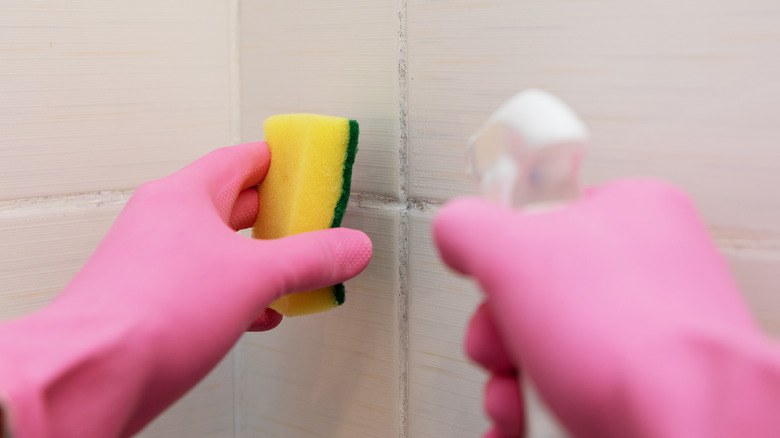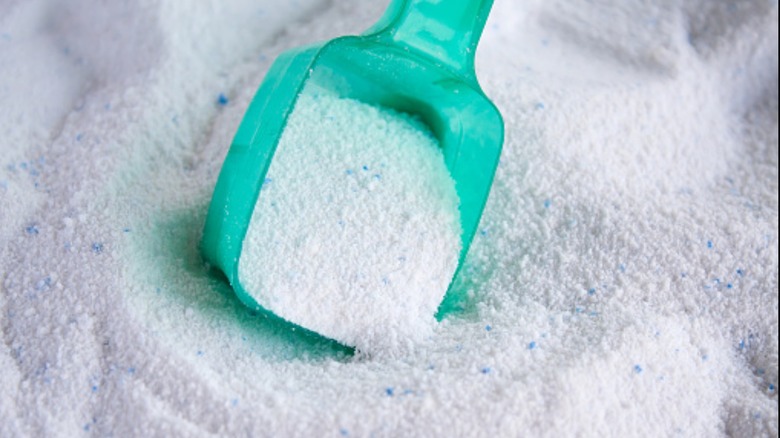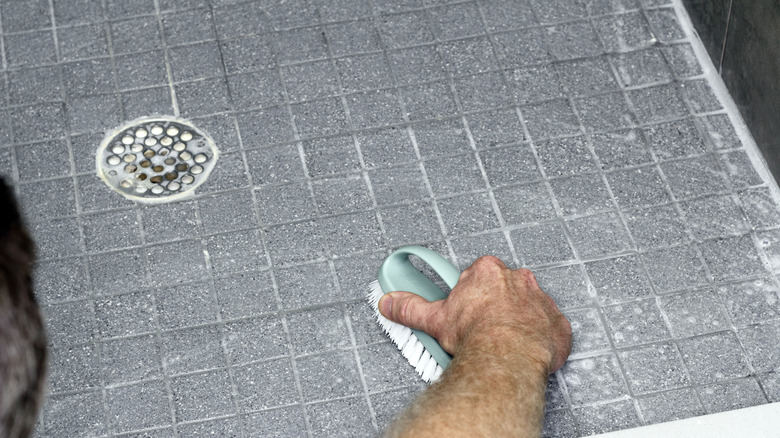Clean Stubborn Grout Effortlessly With A Common Laundry Detergent
There's one task that many people dread, no matter how badly it needs doing or how many times they write it down on their deep-cleaning to-do list: scrubbing dirty tile grout. This cement- and sand-based filler between your kitchen and bathroom tiles is notoriously hard to keep clean — and even harder to remove stains from once they've set in. Mopping doesn't address the deep grooves, and most daily floor cleaners won't strip stains and remove debris. To make grout cleaning a bit easier, you might want to reach for a laundry-day staple: powdered Tide detergent.
Tide laundry powder is particularly well-suited to this task because it contains abrasive surfactants, which help physically remove dirt and grime. The formula also chemically breaks down stains. But why use Tide over other laundry detergents? Tide contains enzymes that break down the proteins left behind from grease, food stains, and more. What's more, the powdered detergent breaks down soap scum in the shower area. Because Tide is formulated to be gentle on fabrics, it's also well-suited for cleaning grout. While the detergent's liquid form may contain similar ingredients, it won't work quite as well on grout because it lacks the powder's abrasive grit and can leave a sticky residue behind.
How to use Tide to clean grout
To both clean and disinfect your grout, mix 2-3 teaspoons of powdered Tide detergent with 4 cups of hot water and 1 cup of bleach. With this mixture, the bleach should be diluted enough to disinfect and lift stains from the porous grout without leaching color from the surrounding non-porous tiles.
Mix the solution in a bucket and grab a bristle brush (or an old toothbrush) to scrub the grout lines. Dip the brush in your Tide-and-water solution, then scrub away at the grout between your floor or wall tiles, wiping away any dirty residue with a clean rag as needed. If you're working with a small area or don't want to keep your cleaning solution in a lid-less bucket, you can always mix the water, Tide, and bleach in a small spray bottle, as long as you adjust the cleaning recipe accordingly. Keep in mind, however, that the solution will rapidly lose efficacy, so don't batch it.
This process still requires a bit of elbow grease, so take breaks, stretch, and consider putting a rolled-up towel or gardening pad under your knees for comfort. Once you're satisfied with your grout cleaning, give the floor a once-over with a mop to gather any displaced dirt, grease, and grime. To prevent the grout lines from quickly becoming dirty again, you may also want to seal your grout lines with a dedicated sealant.
Safety tips when using Tide to clean grout
For the most part, Tide laundry powder is safe to use on many household surfaces, including grout lines. But what about the added bleach? Bleach is safe to mix with Tide laundry powder — after all, detergent and bleach together are one of the most common laundry solutions. But you shouldn't mix bleach with any other cleaning agents, as this can create dangerous gasses.
While bleach and Tide are safe enough for people to use when cleaning, however, they aren't safe to use on all materials and tiles. If you have floors or walls made out of natural stone like marble, never use bleach, even in small doses, to clean your grout lines. Bleach will eat away at the stone and can leak out very easily, even if you try to stay well within the lines — suffice it to say, it's not worth the risk. The good news is that Tide powder should work quite well on its own to lift stains and debris from your grout, though you will want to use another product to disinfect the area.


